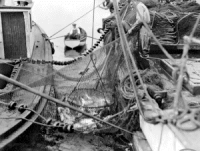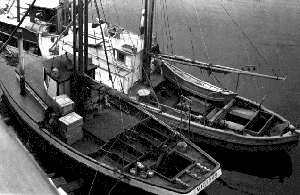 |
Question 2 |
 |
Question 3 |
| |
 |
Glossary |
|
Open Sea
For some weeks after reaching the open sea Spring fed near shore, in fairly shallow water. She began to eat larger food and enjoyed hunting and eating until her belly was full. When the rest of the school worked their way farther from shore, they encountered the Euphasid shrimps, the salmon's own food, in abundance. The salmon learned to look for their food in the deeper depths of the sea and with the passing months they fed more aggressively and grew into young adults. Spring was a full sixteen inches long after her first year at sea.
The school fed and drifted northward to the Swiftsure Bank. This was a great Pacific Salmon crossroads where the Strait of Jaun de Fuca ran out between the Olympic Peninsula and Vancouver Island. Spring had grown to be 20 inches long and weighed a little less than four pounds. She enjoyed pursuing herring and pilchard; and feeling the sensation of a struggling fish in her jaws.
Spring was often near the sockeye salmon. The canneries waited for them, sure of a market for their firm red flesh in the cans.

B.C. Archives image #D-08385
 |
Spring often saw the purse-seining boats near her. Since she was feeding like the sockeyes there was danger for Spring.
Spring survived the summer while many fish in her school were drawn up in huge commercial nets. She was now two feet long, a salmon-sized salmon. Throughout fall and winter her growth slowed. By the spring of her fourth year she was well up the coast of Vancouver Island, off the mouth of Barkley Sound.
Back at Canyon Pool, Senator Evans had heard that the hatcheries were planning on catching the return run of chinooks, and would be putting the fry back into the stream soon after hatching. This would mean that he'd never see his marked chinooks, including Spring, again.
B.C. Archives Image
#D-08382a

|
Meanwhile Spring was feeding along the banks of Ucluelet. Over the feeding fish, the deep sea trollers worked from dawn till dark, carrying ice in their holds so that they could stay at sea for days on end. On one of the trollers, Charlie Wilson, a salmon researcher, was tagging young fish that the troller was catching, and then releasing them again. He was surprised to hook a chinook salmon that had already been marked. It was Spring! Charlie set a metal tag at the base of her tail fin, slipped her back into the water and watched her slowly swim away after the trauma of being hooked. He hoped she'd make it back to her home river.
Throughout the summer Spring continued to drift northward, feeding on pilchards, which would give her the fat needed for her spawning migration. She was now thirty inches long and weighed twelve pounds. She swam from Barkley Sound to Kyuquot, Quatsino and up to Cape Cook. The next summer's feeding carried Spring past Triangle Island and across the open water of Queen Charlotte Sound. By December Spring had reached her full growth; she was forty inches long and weighed a little less than thirty-five pounds.
Top of page.
|

